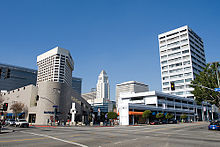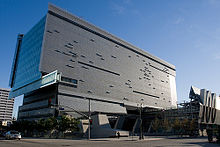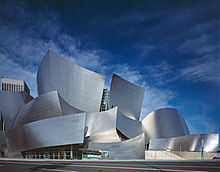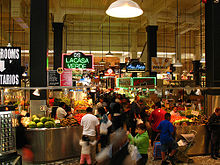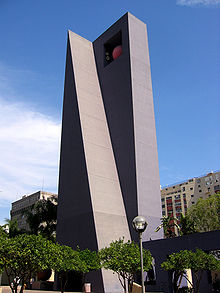|
"Explore Neighborhoods Within Neighborhoods"
| |
Downtown Los AngelesDowntown Los Angeles is the central business district of Los Angeles, California, located close to the geographic center of the metropolitan area. The area features many of the city's major arts institutions and sports facilities, sightseeing opportunities, a variety of skyscrapers and associated large multinational corporations and an array of public art and unique shopping opportunities. Though Downtown is generally thought to be bounded by the Los Angeles River on the east in Lincoln Heights, the Hollywood (101) Freeway to the north, the Santa Monica (10) Freeway on the south and the Harbor (110) Freeway on the west, some sources, including the Los Angeles Downtown News and Los Angeles Times, extend the area past the traditional boundary to include University Park and Exposition Park, encompassing the University of Southern California (USC) and Central City West neighborhoods. 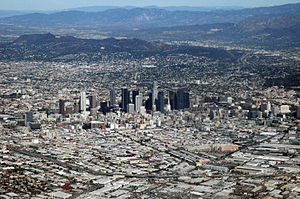
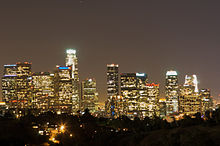
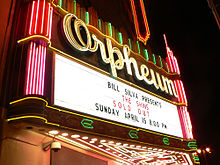
HistoryEarly YearsThe earliest known settlements in the area of what is now Downtown Los Angeles was by the Tongva, a Native American people. Later European settlement arrived after Father Juan Crespí, a Spanish missionary charged with exploring sites for Catholic missions in California, noted in 1769 that the region had "all the requisites for a large settlement." On September 4, 1781, the city was founded on the site that currently holds La Placita Olvera. Land speculation increased in the 1880s, which saw the population of the city explode from 11,000 in 1880 to nearly 100,000 by 1896. Infrastructure enhancements and the laying of a street grid eventually brought development south of the original settlement into what is today the Civic Center and Historic Core neighborhoods. Downtown's Golden AgeBy 1920, the city's private and municipal rail lines were among the most far-flung and most comprehensive in the world in mileage, rivaling that of New York City, as shown (and parodied) in the 1988 film Who Framed Roger Rabbit. By that year, a steady influx of residents and aggressive land developers had transformed the city into a large metropolitan area, with Downtown at its center. Rail lines connected four counties with over 1,100 miles of track. During the early part of the 20th century, banking institutions clustered around South Spring Street, forming the Spring Street Financial District. Sometimes referred to as the "Wall Street of the West," the district held corporate headquarters for financial institutions including Bank of America, Farmers and Merchants Bank, the Crocker National Bank, California Bank & Trust, and International Savings & Exchange Bank. The Los Angeles Stock Exchange was also located on the corridor from 1929 until 1986 before moving into a new building across the Harbor (110) Freeway. Commercial growth brought with it hotel construction—during this time period several grand hotels, the Alexandria (1906), the Rosslyn (1911), and the Biltmore (1923), were erected—and also the need for venues to entertain the growing population of Los Angeles. Broadway became the nightlife, shopping and entertainment district of the city, with over a dozen movie houses built before 1932. Department stores also opened flagship stores in Downtown, including The Broadway, Hamburger & Sons, May Company, JW Robinson's and Bullock's, serving a wealthy residential population in the Bunker Hill neighborhood. Numerous specialty stores also flourished including those in the jewelry business which gave rise to the Downtown Jewelry District. Among these early Jewelers included the Laykin Diamond Company (later becoming Laykin et Cie) and Harry Winston & Co. both of which found their beginnings in the Alexandria Hotel at 5th and Spring Streets. The Los Angeles Union Passenger Terminal (Union Station) opened in May, 1939, unifying passenger service among various local, regional and long-distance passenger trains. Decline and Redevelopment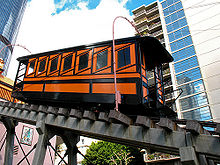
Following World War II, suburbanization, the development of the Los Angeles freeway network and, subsequently, increased automobile ownership, led to decreased investment in Downtown. Many corporate headquarters slowly dispersed to new suburbs or fell to mergers and acquisitions. The once-wealthy Bunker Hill neighborhood became a haven for low-income renters, its stately Victorian mansions turned into flophouses. From about 1930 to the 1960s, numerous very old and historic buildings in the Plaza area were demolished to make way for street-level parking lots, the high demand for parking making this more profitable than any other option that might have allowed preservation. The drastic reduction in the number of residents in the area further reduced the viability of streetfront businesses that would be able to attract pedestrians. For most Angelenos, Downtown became a drive-in-drive-out destination as they would come into the area for a particular objective, and then leave immediately once their business was completed. In an effort to combat blight and lure businesses back to Downtown, the Community Redevelopment Agency of the city of Los Angeles undertook the Bunker Hill Redevelopment Project in 1955, a massive clearance project that leveled homes and cleared land for future commercial skyscraper development. This period saw the clearing and upzoning of the entire neighborhood as well as the shuttering of the Angels Flight funicular railway in 1969. Angels Flight resumed operation in 1996 for a period of five years, shutting down once again after a fatal accident in 2001. On March 15, 2010, the railway once again opened for passenger service following extensive upgrades to brake and safety systems. With Class A office space becoming available on Bunker Hill, many of Downtown's remaining financial corporations moved to the newer buildings, leaving the former Spring Street Financial District devoid of tenants above ground floor. Following the corporate headquarters' moving six blocks west, the large department stores on Broadway shuttered, culminating in the 1980s. However, the Broadway theaters saw much use as Spanish-language movie houses during this time, beginning with the conversion of the Million Dollar Theater in the 1950s to Spanish-language film. Recent Years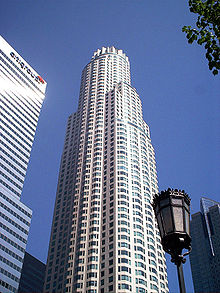
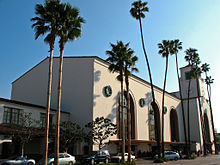
Because of the Downtown office market's migration west to Bunker Hill and the Financial District, many historic office buildings were left intact, simply used for storage or remaining empty during recent decades. In 1999, the Los Angeles City Council passed an adaptive reuse ordinance, making it easier for developers to convert outmoded, vacant office and commercial buildings into renovated lofts and luxury apartment and condo complexes. As of early 2009, 14,561 residential units have been created under the adaptive reuse ordinance, leading to an increase in the residential population. With 28,878 residents in 2006 and 39,537 in 2008, a 36.9% increase, Downtown Los Angeles is seeing new life and investment.
Projects along the Figueroa Corridor such as Wilshire Grand Tower I are also being approved that will further the progressive revitalization of downtown; attracting businesses, tourists and new residents, and rivaling other spots, like Times Square. With the addition of new skyscrapers such as the Wilshire Towers, Downtown is slated to have a skyline in prominence rivaling those ranked among the top in the world. Neighborhoods and attractionsPueblo (Union Station and Olvera Street)
Chinatown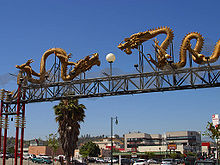
North and west of Union Station lies Chinatown, a mixed-use district of restaurants, nightlife, art galleries, trinket shops, a branch of the Los Angeles Public Library system and residences. The neighborhood is accessible via the Metro Gold Line Chinatown Station.
Little Tokyo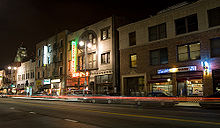
Despite the suburbanization of Southern California's Japanese Americans over the past several decades, Little Tokyo remains the cultural heart of the Japanese American community. The neighborhood is home to several Buddhist temples, dozens of shops, restaurants and taverns, two museums, and a branch of the Los Angeles Public Library system. Little Tokyo is accessible via the nearby Metro Red/Purple Line Civic Center Station, and the Little Tokyo light-rail station on the Metro Gold Line.
Civic Center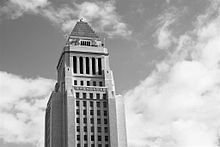
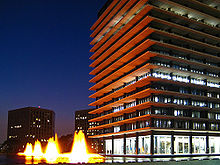
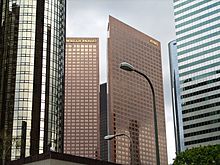
Los Angeles's Civic Center is the government center of the city and is home to several federal, state, county and municipal administrative buildings. The main office of the Los Angeles Times is located in the district. The neighborhood is accessible via the Metro Red/Purple Line Civic Center Station.
Bunker HillBunker Hill is the cultural heart of Los Angeles, with several arts schools, theaters and performance venues along Grand Avenue. Guided tours of the neighborhood are provided by the Los Angeles Conservancy for a small fee. The neighborhood is accessible via the Metro Red/Purple Line Civic Center Station.
Historic Core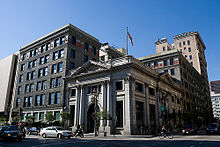
The Historic Core neighborhood is a heavily residential neighborhood of Downtown Los Angeles, and many of those residences are adaptive reuse loft units created from formerly vacant historic commercial and office buildings. The neighborhood is accessible via the Metro Red/Purple Line Pershing Square Station.
Financial District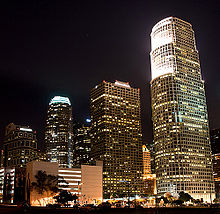
South of Bunker Hill is the Financial District of Downtown Los Angeles, the center for corporate headquarters and skyscrapers in Los Angeles. The neighborhood is accessible via the Metro Red/Purple/Blue Line 7th Street/Metro Center Station.
South Park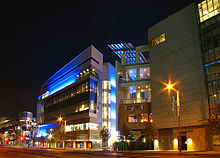
South Park is a growing residential and entertainment neighborhood consisting of the Los Angeles Convention Center, Staples Center and the mixed-use L.A. Live entertainment campus. The area has seen a revival due to an increase in new residential buildings and restaurants. The neighborhood is accessible via the Metro Blue Line Pico/Chick Hearn Station.
Other Districts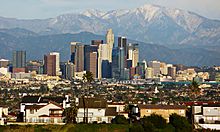
Downtown contains other smaller or lesser known districts:
As well as, a Seafood District and Produce District.
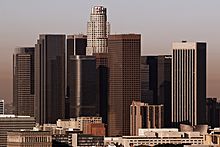
SkylineDespite its relative decentralization, Los Angeles has one of the largest skylines in the United States, and its development has continued in recent years. The skyline has seen rapid growth due to improvements in seismic design standards, which has made certain building types highly earthquake-resistant. Many of the new skyscrapers contain a housing or hotel component. Building height limits: 1904-1957The first height limit ordnance in Los Angeles was enacted following the completion of the 13-story Continental Building, located at the southeast corner of 4th and Spring streets. The purpose of the height limit was to limit the density of the city. There was great hostility to skyscrapers in many cities in these years, mainly due to the congestion they could bring to the streets, and height limit ordinances were a common way of dealing with the problem. In 1911, the city passed an updated height limit ordinance, establishing a specific limit of 150 feet. Exceptions were granted for decorative towers such as those later built on the Eastern Columbia Building and United Artists Theatre, as well as the now-demolished Richfield Tower. Though it is commonly believed that the height limits were imposed due to the risk of earthquakes, such limits were actually enacted to allow California's natural sunlight to penetrate to sidewalk level, avoiding the "urban canyon" effects of New York and Chicago. It is notable that the first limit was imposed in 1904, two years before the 1906 San Francisco earthquake, and that even after that seismic event it was believed that Southern California was not subject to such violent temblors, despite evidence to the contrary. The 1911 ordinance was repealed in 1957. The first private building to exceed the old limit was the 18-story California Bank Building, located at the southeast corner of 6th and Spring streets. Parks and Open Space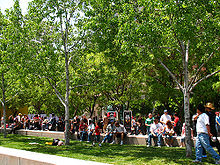
Downtown Los Angeles is home to several public parks, plazas, gardens and other open space:
Additionally, several semi-public open spaces sit on private property. Public access may be restricted at certain times.
Several future park proposals in Downtown make use of public-private partnerships between developers and the city of Los Angeles, including a public park at the proposed Nikkei Center development in Little Tokyo; a 1-acre park at the Medallion development in the Historic Core; and a pocket park at the Wilshire Grand Hotel replacement project, currently in the planning phase. Additionally, the city of Los Angeles is in the planning stage on a new park to be located on the 400 block of South Spring Street in the Historic Core neighborhood. Preview all properties for sale below: Preview all income properties for sale here: |

